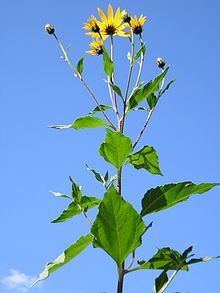[edit]
It is a herbaceous perennial plant growing to 1.5–3 metres (4 ft 10 in–9 ft 10 in) tall with opposite leaves on the upper part of the stem but alternate below.[3] The leaves have a rough, hairy texture and the larger leaves on the lower stem are broad ovoid-acute and can be up to 30 centimetres (12 in) long, and the higher leaves smaller and narrower.
The flowers are yellow and produced in capitate flowerheads, which are 5–10 centimetres (2.0–3.9 in) in diameter, with 10–20 ray florets.
The tubers are elongated and uneven, typically 7.5–10 centimetres (3.0–3.9 in) long and 3–5 centimetres (1.2–2.0 in) thick, and vaguely resembling ginger root, with a crisp texture when raw. They vary in colour from pale brown to white, red, or purple.[2][4]
The artichoke contains about 10% protein, no oil, and a surprising lack of starch. However, it is rich in the carbohydrate inulin (76%), which is a polymer of the monosaccharide fructose. Tubers that are stored for any length of time will digest their inulin into its component fructose. Jerusalem artichokes have an underlying sweet taste because of the fructose, which is about one and a half times sweeter than sucrose.[5]
Jerusalem artichokes have also been promoted as a healthy choice for diabetics. This is because fructose is better tolerated by people that are diabetic. It has also been reported as a folk remedy for diabetes.[5] Temperature variances have been shown to affect the amount of inulin the Jerusalem artichoke can produce. When not in tropical regions, it has been shown to make less inulin than when it is in a warmer region












 n organism that is not an animal, especially an organism capable of photosynthesis. Typically a small or herbaceous organism of this kind, rather than a tree. [quotations ▼]
The garden had a couple of trees, and a cluster of colourful plants around the border.
(botany) An organism of the kingdom Plantae; now specifically, a living organism of the Embryophyta (land plants) or of the Chlorophyta (green algae), a eukaryote that includes double-membraned chloroplasts in its cells containing chlorophyll a and b, or any organism closely related to such an organism.
(ecology) Now specifically, a multicellular eukaryote that includes chloroplasts in its cells, which have a cell wall.
(proscribed as biologically inaccurate) Any creature that grows on soil or similar surfaces, including plants and fungi.
A factory or other industrial or institutional building or facility.
An object placed surreptitiously in order to cause suspicion to fall upon a person.
That gun's not mine! It's a plant! I've never seen it before!
Anyone assigned to behave as a member of the public during a covert operation (as in a police investigation).
A person, placed amongst an audience, whose role is to cause confusion, laughter etc.
(snooker) A play in which the cue ball knocks one (usually red) ball onto another, in order to pot the second; a set. [quotations ▼]
A large piece of machinery, such as the kind used in earthmoving or construction.
(obsolete) A young tree; a sapling; hence, a stick or staff. [quotations ▼]
(obsolete) The sole of the foot. [quotations ▼]
(dated, slang) A plan; a swindle; a trick. [quotations ▼]
An oyster which has been bedded, in distinction from one of natural growth.
(US, dialect) A young oyster suitable for transplanting.
n organism that is not an animal, especially an organism capable of photosynthesis. Typically a small or herbaceous organism of this kind, rather than a tree. [quotations ▼]
The garden had a couple of trees, and a cluster of colourful plants around the border.
(botany) An organism of the kingdom Plantae; now specifically, a living organism of the Embryophyta (land plants) or of the Chlorophyta (green algae), a eukaryote that includes double-membraned chloroplasts in its cells containing chlorophyll a and b, or any organism closely related to such an organism.
(ecology) Now specifically, a multicellular eukaryote that includes chloroplasts in its cells, which have a cell wall.
(proscribed as biologically inaccurate) Any creature that grows on soil or similar surfaces, including plants and fungi.
A factory or other industrial or institutional building or facility.
An object placed surreptitiously in order to cause suspicion to fall upon a person.
That gun's not mine! It's a plant! I've never seen it before!
Anyone assigned to behave as a member of the public during a covert operation (as in a police investigation).
A person, placed amongst an audience, whose role is to cause confusion, laughter etc.
(snooker) A play in which the cue ball knocks one (usually red) ball onto another, in order to pot the second; a set. [quotations ▼]
A large piece of machinery, such as the kind used in earthmoving or construction.
(obsolete) A young tree; a sapling; hence, a stick or staff. [quotations ▼]
(obsolete) The sole of the foot. [quotations ▼]
(dated, slang) A plan; a swindle; a trick. [quotations ▼]
An oyster which has been bedded, in distinction from one of natural growth.
(US, dialect) A young oyster suitable for transplanting.